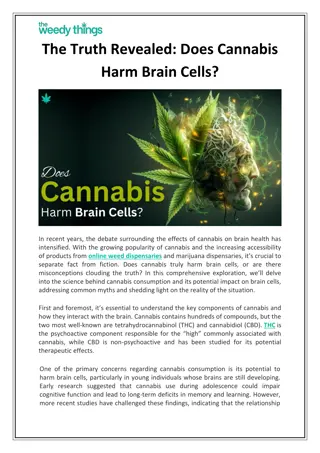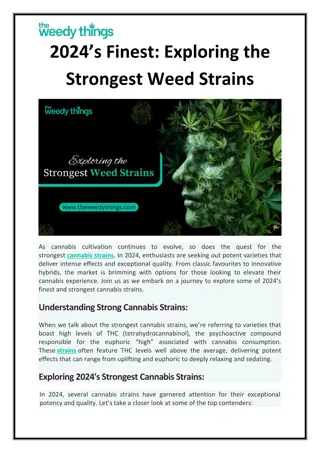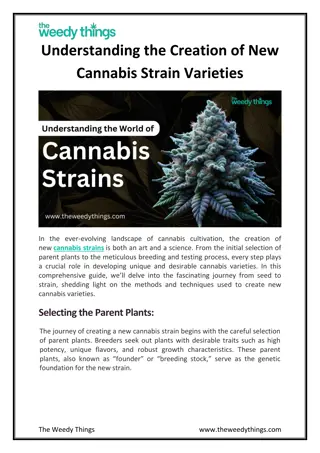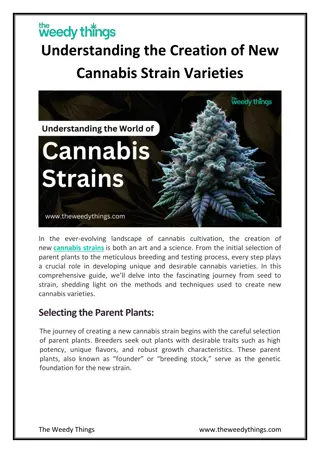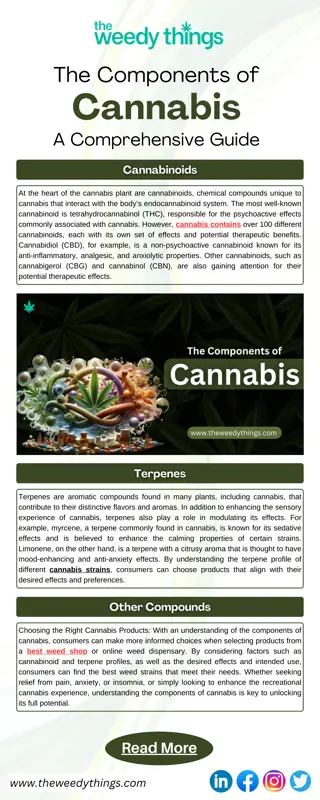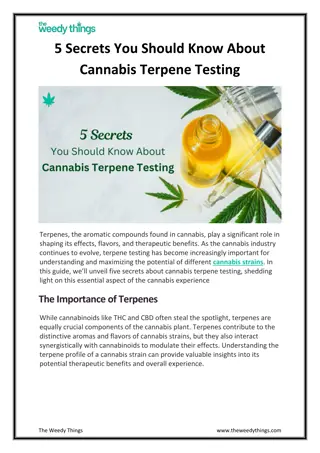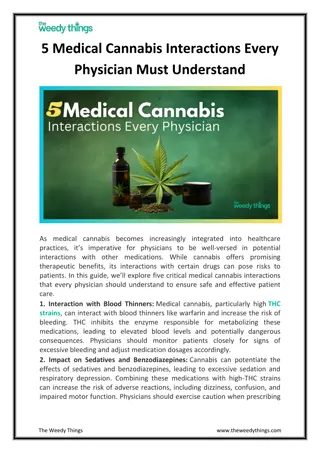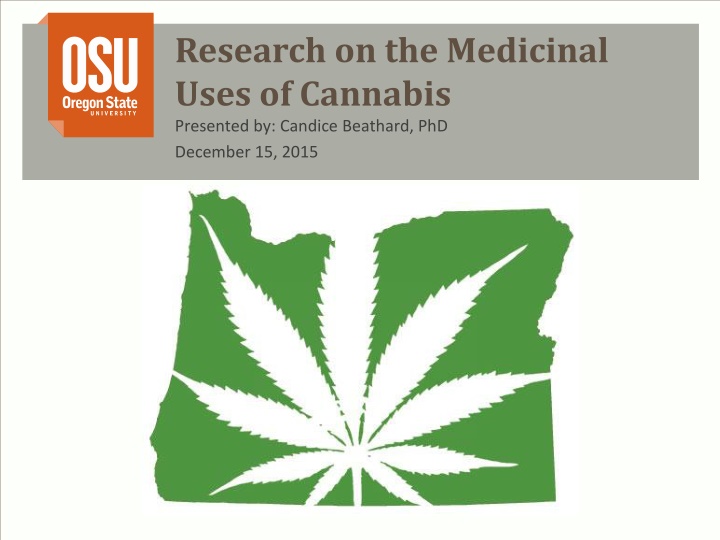
Medicinal Uses of Cannabis: A Comprehensive Overview
Cannabis has a rich history in medicine dating back to ancient times. This presentation by Candice Beathard, Ph.D., explores the clinical research, benefits, and challenges associated with cannabis and cannabis-derived products. Discover the strong support for treating nausea, chronic pain, spams, and more, as well as emerging research areas like anxiety disorders and epilepsy.
Download Presentation

Please find below an Image/Link to download the presentation.
The content on the website is provided AS IS for your information and personal use only. It may not be sold, licensed, or shared on other websites without obtaining consent from the author. If you encounter any issues during the download, it is possible that the publisher has removed the file from their server.
You are allowed to download the files provided on this website for personal or commercial use, subject to the condition that they are used lawfully. All files are the property of their respective owners.
The content on the website is provided AS IS for your information and personal use only. It may not be sold, licensed, or shared on other websites without obtaining consent from the author.
E N D
Presentation Transcript
Research on the Medicinal Uses of Cannabis Presented by: Candice Beathard, PhD December 15, 2015
Background: History of Cannabis as Medicine Dates back to 2727B.C. in China1 In U.S 1850: cannabis tinctures patented2 1963: chemical structure of cannabis identified3 1970s: increased number of publications4 1990s: increased interest again due to genetic cloning4 1. Drug Enforcement Administration. 2. ProCon.org. 3. Michoulam, R, Shvo, Y., 1963. 4. Zuardi, 2008.
Introduction: Clinical Research Cannabis plant is one of the most researched substances 22,000 published studies or reviews5 Gold standard of research is problematic6 Methodological challenges Ethical, political, legal, practical Schedule I controlled substance7 True randomization is rare Ethical barriers limit dosage Generalizability issues with animal models Problems with observational research FDA s role in approving cannabis-derived products 5. National Center for Biotechnology Information. 6. Caulkins et al., 2015. 7. Drug Enforcement Administration, 2015.
Research Clinical, pre-clinical, observational, animal Strong Support Nausea, chemotherapy Chronic pain Spasms and tics Appetite stimulation, wasting syndrome Intermediate Support Glaucoma Cancer Emerging Research Anxiety disorders, PTSD Epilepsy Opioid use disorder
Strong Support Nausea, Chemotherapy One of the first therapeutic uses of cannabis and cannabinoids that was evaluated with clinical trials Mid 1970s 33 Clinical Trials (N=8-172)
Strong Support Chronic Pain Used to treat chronic pain for centuries in traditional medicine 32 Clinical Trials (N=1-125) Neuropathic pain Recent work: California, 4 clinical trials all four demonstrating a significant decrease in pain after cannabis administration. 8 8. Center for Medicinal Cannabis Research., 2010.
Strong Support Spasms and Tics 30 Clinical Trials (N=1-630) Multiple sclerosis Gilles de la Tourette s syndrome
Strong Support Appetite Stimulation, Wasting Syndrome THC shows to be useful in stimulating appetite and preventing weight loss in cancer and AIDS patients 9 Clinical Trials (N=12-469)
Intermediate Support Glaucoma Significant reduction in intraocular pressure 3 Clinical Trials (N=8-18) The beneficial effects of cannabis are limited by its short-term action (a few hours) Not supported by American Glaucoma Society
Intermediate Support Cancer Mainly Animal Models > 60 studies 1 pilot study Research began in 1970s, renewed in 2000s Three recent review articles demonstrate the anti-proliferative action of cannabinoids in brain, prostate, breast, lung, skin, pancreatic, uterine, thyroid, and lymphoma cancer cells.9-11 9. Sarfaraz et al., 2008. 10. Chakravarati et al., 2014. 11. Alexander et al., 2009.
Emerging Research Anxiety Disorders, PTSD Emerging research Veterans 2 studies underway in Colorado 3 Clinical Trials (N=47-60)
Emerging Research Epilepsy Several anecdotal reports suggest that cannabis has anticonvulsant properties 4 Clinical Trials (N=9-15) Many states have implemented expanded access research programs after high profile cases of pediatric epilepsy
Research Additional studies Intestinal dysfunction, Inflammatory bowel disease, Parkinson disease, spinal cord injury What are the research gaps? Conflicting research Schizophrenia, Hepatitis C Small studies: Diabetes, Sleep, Alcohol and substance use addiction, BMI and waist circumference Amyotrophic lateral sclerosis, leukemia ??
Discussion Questions 1. Is there a need for research on the medical and public health benefits of cannabis? 2. Should the state support a program designed to meet that need? 3. Would the state want to focus research to a list of specific conditions? If so, which? 4. Would the state want to focus research to specific products (i.e. hemp extract, low THC oil, FDA approved pharmaceuticals, etc.)?
References 1. Drug Enforcement Administration. Cannabis, coca, & poppy: Nature s addictive plants, history. Retrieved from http://www.deamuseum.org/ccp/cannabis/history.html Accessed December 4, 2014. ProCon.org. Historical timeline: History of marijuana as medicine-2900 BC to present. Retrieved from http://medicalmarijuana.procon.org/view.timeline.php?timelineID=000026. Accessed October 27, 2015. Michoulam, R, Shvo, Y. Hashish: I. (1963). The structure of cannabidiol. Tetrahedron. 9(12):2073-8. Zuardi, AW. Cannabidiol: from an inactive cannabinoid to a drug with wide spectrum of action. Rev Bras Psiquiatr. 2008;30(3):271-80. National Center for Biotechnology Information. Search NCBI databases. Retrieved from http://www.ncbi.nlm.nih.gov/gquery/?term=marijuana. Accessed November 17, 2015. Caulkins, J.P., Kilmer, B., Kleiman, M.A.R., MacCoun, R.J., Midgette, J., ... Reuter, P.H. (2015). Considering Marijuana Legalization: Insights for Vermont and Other Jurisdictions. Santa Monica, CA: RAND Corporation. Retrieved from http://www.rand.org/pubs/research_reports/RR864. Drug Enforcement Administration. (2015). Drug scheduling. Retrieved from http://www.dea.gov/druginfo/ds.shtml. Accessed October 27, 2015. Center for Medicinal Cannabis Research. Report to the legislature and governor of the state of California presenting findings pursuant to SB847 which created the CMCR and provided state funding. Retrieved from http://cmcr.ucsd.edu/images/pdfs/cmcr_report_feb17.pdf. Accessed October 15, 2015. Sarfaraz, S, Adhami, V M, Syed, D N, Afaq, F, Mukhtar, H. (2008). Cannabinoids for cancer treatment: Progress and promise. Cancer Res. 68(2):339-42. doi: 10.1158/0008-5472.CAN-07-2785. Chakravarati, B, Ravi, J, Ganju, R K. Cannabinoids as therapeutic agents in cancer: Current status and future implications. Oncotarget.2014;5(15):5852-72. Alexander, A., Smith, P. F., & Rosengren, R. J. (2009). Cannabinoids in the treatment of cancer. Cancer letters, 285(1), 6-12. 2. 3. 4. 5. 6. 7. 8. 9. 10. 11.









